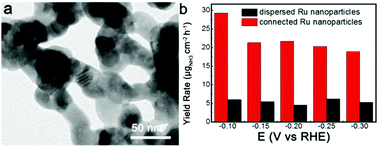Connection of Ru nanoparticles with rich defects enables the enhanced electrochemical reduction of nitrogen†
Abstract
The electrochemical reduction of N2 into NH3 under ambient conditions is an attractive topic in the chemical industry, but the chemical inertness of N2 and the competing hydrogen evolution reaction hamper the activity and selectivity of this reaction. Herein, we connected Ru nanocrystals through a facile annealing process, which constructed intraparticle grain boundaries and stacking faults in the connection regions to enhance the N2 reduction reaction. The connected Ru nanoparticles exhibited an enhanced yield rate and faradaic efficiency for NH3 production. At −0.1 V versus RHE, the connected Ru nanoparticles exhibited a maximum yield rate of 29.3 μg cm−2 h−1 (148.0 μg mgcat−1 h−1) for NH3 production with a faradaic efficiency of 7.0%. Mechanistic study revealed that the promotion of the electrochemical reduction of N2 over connected Ru nanoparticles could be attributed to the decreased work function and facilitated electron transfer, which originated from the abundant defects in the connection region.

- This article is part of the themed collection: Stability and properties of new-generation metal and metal-oxide clusters down to subnanometer scale


 Please wait while we load your content...
Please wait while we load your content...